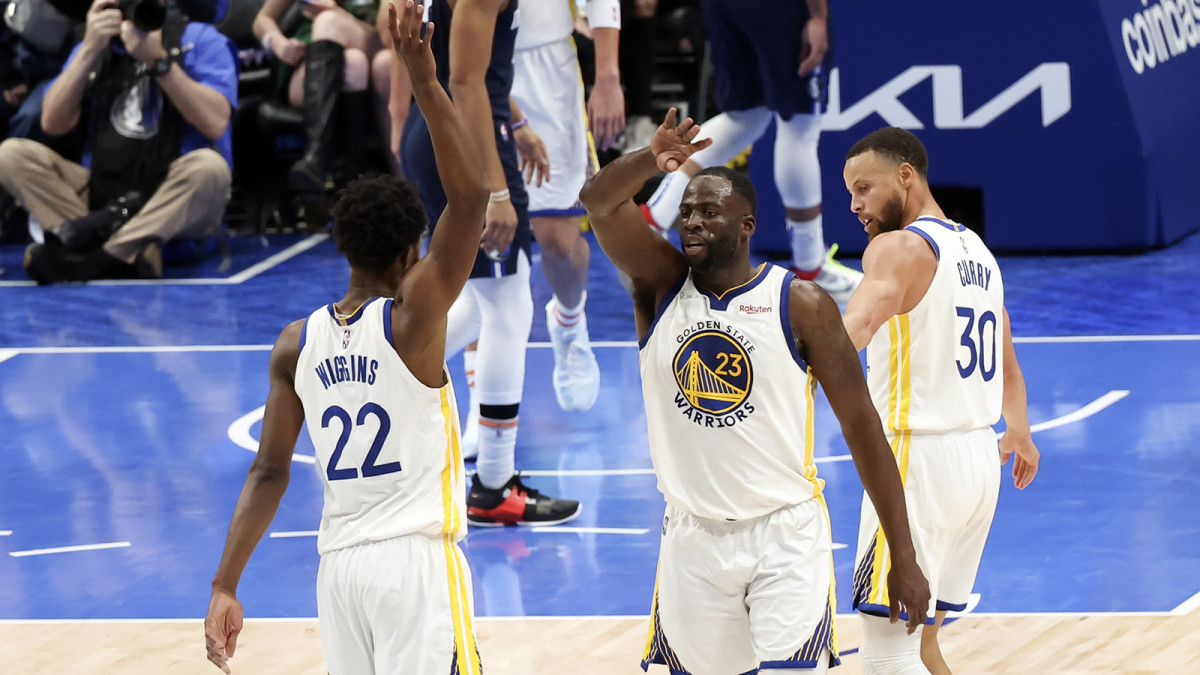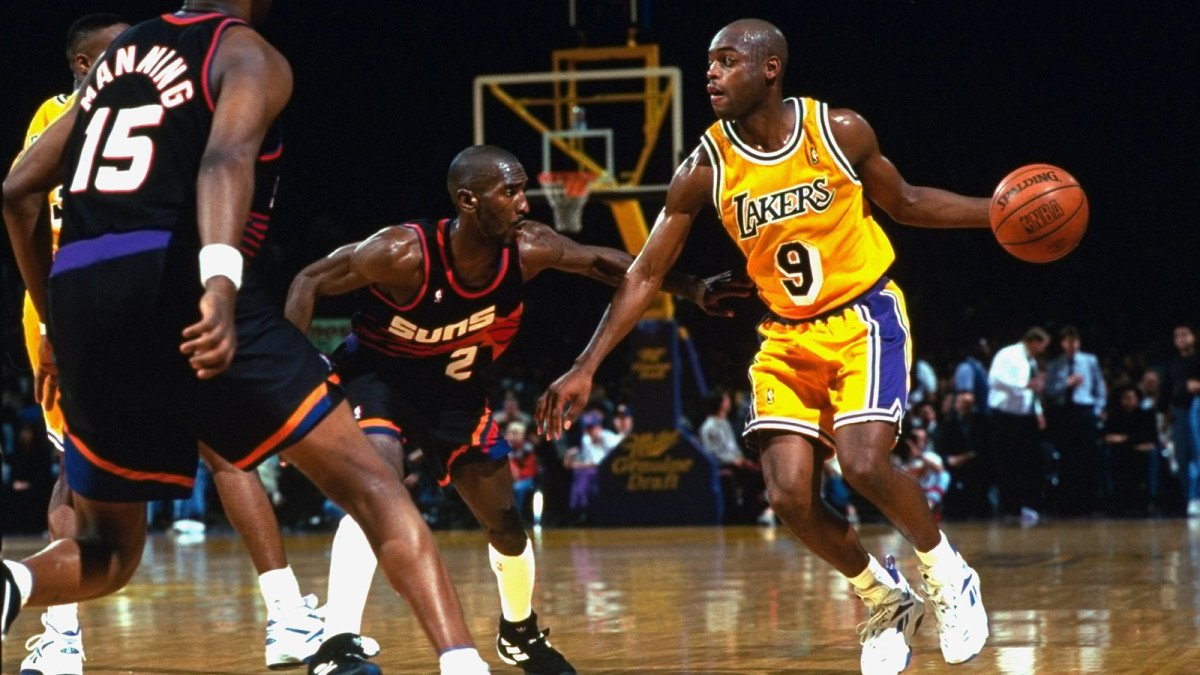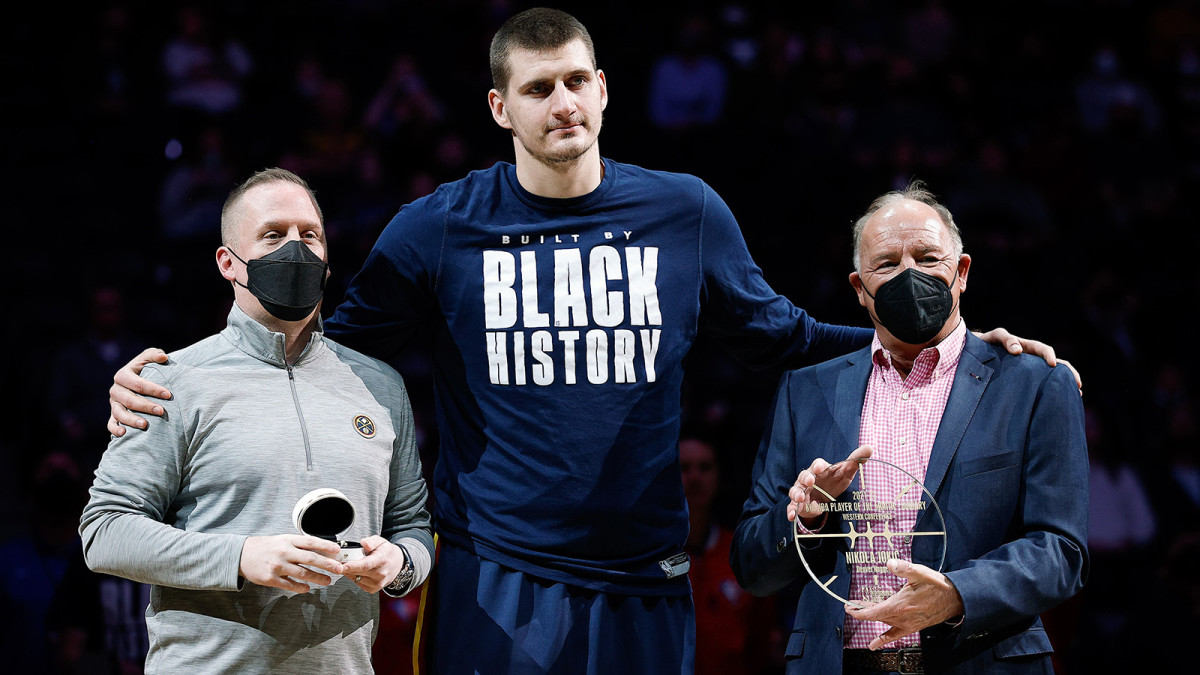So, About My Warriors-Mavs Prediction ...
If we turn back the clock precisely a week ago, there was a man who made a particularly bold claim: The red-hot Mavericks, fresh off embarrassing the top-seeded Suns, would also go on to knock off the Warriors to reach the NBA Finals.
The column laid out valid enough reasoning, highlighting Dallas’s stout defense—and the fact that the Mavs had contained Stephen Curry better than just about anyone during the year—while raising the question of who, if anyone, could slow down the unslowdownable Luka Dončić. The Mavericks take care of the ball better, and, when they’re at their best, can generate and knock down open threes at a higher clip than the Warriors.
As you might have noticed, Golden State has made the man who penned that piece look funny in the light. Yes, that would be me, having to own the fact that I thought Dallas could—would—take out the Warriors in the conference finals matchup, a notion that could be fully obliterated by late Tuesday night given that the Dubs are up 3–0 to begin the series.
All sorts of things would explain how the Warriors have taken the series by the throat.
- The Mavs are making more triples than Golden State, as we suggested here that they might. Yet their efficiency from outside has been absolutely awful. At just 33.8% (27-for-80) from deep when left wide open, Dallas’s success rate over the first three games is not only considerably worse than the other three teams left in the playoffs, it would also rank as the worst in the NBA—even worse than the 23-win Pistons—if looked at within the content of the league’s regular-season metrics. By himself, Reggie Bullock shot a ghastly 0-for-10 in Game 3, including 0-for-7 from deep.
- Kevon Looney, the generally quiet center, has made life miserable for Dallas on the offensive glass and as a dump-off man, who consistently maneuvers behind the Mavs’ confused, overextended defense. (Not to mention that Dončić has spent too many plays essentially trying to take Looney one-on-one, despite Looney holding up fine in those matchups.)
- And while the highly turnover-prone Warriors—who fumble away the second-most possessions in the NBA—have turned the ball over more in this series than Dallas, they haven't been as sloppy as usual, keeping the shot totals equivalent enough to win.
But the more difficult thing to project, and the thing that’s still somewhat hard to believe, is the fact that Andrew Wiggins, the enigmatic former No. 1 pick, has dictated so much about this series and why it’s turned out to be so one-sided.
Wiggins is the player who’s been tasked with defending Dončić the most, and he has occasionally made life difficult for him. The performance that comes to mind, in some ways, is fellow Warrior Andre Iguodala, from back in 2015, when he won Finals MVP for helping contain LeBron James—a phrasing that seems odd, considering The King averaged 35.8 points, 13.3 boards and 8.8 assists, albeit on poor, un-Bronlike efficiency. (So far, Dončić’s efficiency—45.3% overall, 41.4% from deep, while averaging 34 points and 7.7 rebounds—has largely outpaced his own metrics from the regular season. And according to NBA.com’s matchup data, the Mavs’ star has shot 59.1%, hitting 13 of his 22 tries and scoring 34 points in the 108 possessions or so that Wiggins has been on him.)

Still, though, as my colleague Rohan Nadkarni pointed out: Even with Dončić playing efficiently, Dallas as a club has scored just 0.99 points per possession with Wiggins on Dončić. Jalen Brunson has bullied his way into baskets and averaged 20-plus. But aside from him, no one else has been reliable from one game to the next—a scenario the Warriors know they can key in on by throwing an array of different looks at Dončić, including box-and-ones.
There’s also plenty to be said for the other side of the ball, where Wiggins is utilizing the strategy the Mavs used to perfection a round ago: To repeatedly make the opposing team’s primary ballhandler work far harder than usual on defense. Dončić and Brunson wore down the aging Chris Paul with one screen-and-roll after another, getting him switched into the action. In this series, though, Dončić has often been the hunted again. Wiggins has played with a level of aggression he rarely illustrates when he gets Luka on an island. It’s part of how Wiggins has logged 20.7 points, 7 rebounds and 3.7 assists in the series on stellar efficiency.
All told, Wiggins has been basically just as effective on offense against Dončić as Dončić has been against him. He’s tallied 52 points in the 30 minutes he’s had the superstar on him, shooting 53.1% overall (17-for-32), 46.7% from three, while drawing six shooting fouls. It’s forced Dončić, a player who still struggles with lateral movement on D, to exert whatever energy he has left from putting his team on his back offensively on the defensive end. And it’s an almost cruel exercise, given how much mental and physical stamina is required to guard the Warriors, which treat their offensive possessions like a sped-up version of the teacup rides at Disney, with multiple players racing around, screening for one another in weird spots.
Watch NBA games online all season long with fuboTV: Start with a 7-day free trial!
You have to be prepared for Steph to pass the ball to Draymond Green, shake free and relocate along the arc somewhere. You have to watch for Klay Thompson, who’s always prone to use his ability to sniper to make you forget that he’s great at using backcuts. Jordan Poole utilizes some of the same tricks and has developed a nifty, off-the-dribble scoop game to go with his traits as a sharpshooter. Plugging Wiggins in as a fourth option into that group, and just telling him to floor the gas, keeps things simple for him while leaving the Mavs trapped in relative chaos. It was part of the reason why Dallas looked beyond lost as it blew a 19-point advantage and couldn’t string together stops in the final quarter of Game 2. The Warriors shot 15-for-19 from the field in the fourth, scoring a whopping 43 points that quarter while repeatedly exposing the Mavs’ nonexistent backside help around the basket.
Golden State’s offense has routinely broken the notion of what basketball is supposed to look like. Steph often does that on his own, even at times within this series. He, Klay and Kevin Durant took it to a different level for three years. This year’s return of Thompson, paired with the emergence of Poole, has given the Warriors a new look that makes Wiggins dangerous in a way he probably couldn’t have ever been as a No. 1 or even a No. 2 scorer with the Timberwolves.
Curry’s called this the best stretch of basketball this new iteration of Warriors has played, while Kerr said Golden State would be dead without Wiggins’s playoff contributions—a point that’s driven home by the fact that Wiggins’s on-off differential this postseason is the biggest of any player remaining in the playoffs, at a blistering 22.4 points per 100 possessions.
This fourth-option version of Wiggins is detonating my series prediction, just like he did with the absolutely violent dunk he threw down on Dončić in Game 3. And that’s perfectly fine; my ego can take the hit without having to flop.
In all seriousness, it’s refreshing to watch a player who’s been written off in one role completely thrive in a different one, perhaps to the point where he can be a key, driving force in a dynasty expanding its championship window.
Who woulda thunk it? Obviously not me as of a week ago.
Meat and potatoes: Good reads from SI and elsewhere this past week

Just in case the conference finals have been a bit … too blown out for you, with too many 30-point margins, there’s plenty of other material to dive into. Howard Beck has a great piece on the Cancun tradition that’s always talked about within NBA playoff elimination circles.
Chris Mannix was in the mysterious NBA draft lottery room last week and did a behind-the-scenes write-up on what that process is like to be a part of. (Having done it once myself, it is deeply strange—both because you’re being entrusted to watch the spectacle to ensure that it isn’t rigged, and because, for 45 minutes or so, you know this massive secret that almost no one else on the planet knows. But you can’t share it with anyone, because you have to hand over your electronics as you walk into the room.)
I wrote a piece essentially crying tears of respect for Danny Green’s career, if this is the last we’ve seen of one of the league’s premier role players over the last decade. On that same wavelength, Rohan wrote a great feature on undrafted Miami wing Max Strus.
Mannix covered the bizarre Game 4 last night in Boston, as the Celtics kept up the trend of relative blowouts in a series where the two Eastern Conference finalists seem evenly matched when at full strength. And Michael Pina has been analyzing different aspects of the series since it began.
Similarly, Beck has written on Golden State’s incredible on-court chemistry and the club’s one-of-a-kind comeback ability making a comeback. Beck also podcasted with our draft expert, Jeremy Woo, as they spoke about this year’s incoming draft class on The Crossover.
The Ringer’s Mirin Fader wrote a really interesting feature on Iowa’s Keegan Murray, a late bloomer who’s flown under the radar for most of his basketball life, but now is on the cusp of landing high in the lottery in next month’s NBA draft.
Nekias Duncan, the young, talented reporter for Basketball News, had a great week, not only landing analyst J.J. Redick on The Dunker Spot podcast he cohosts, but also appearing on The Lowe Post with ESPN’s Zach Lowe for the first time. If you don’t know him already, you likely will soon. He’s one of the nicest people in the industry, but also one of the very brightest in terms of spelling out the game to people eager to understand it better.
The Athletic’s Tim Cato had a really cool piece on the unbelievable pride Slovenians have in Dončić. He spoke to an array of Luka fans from the nation, including a television broadcaster in Slovenia named Luka Štucin, who has firm indications that everyone—even a number of elderly grandmothers, perhaps—is staying up all hours of the night in hopes of watching Dončić’s games live.
Denver Post reporter Mike Singer had a fun, detailed story about how the Nuggets’ brass staged a covert trip to Serbia to surprise Nikola Jokić with his second MVP award.
Musing on the Connelly-to-Minnesota move

If you were to play an NBA word association game, and someone threw you a Denver prompt, your first response might be “Jokić.” (If not, then maybe “altitude.” But you get the point.)
Somewhere, eventually, though, “stability” would deserve to be associated with the Nuggets, too. Jokić is in place there. Michael Malone is one of the better coaches in the league, and his players seem to swear by him. Injured stars Jamal Murray and Michael Porter Jr. are locked into max contracts alongside the Joker, who’s coming off a second consecutive MVP season. And the club, led by executive Tim Connelly, has ranked near the top of the sport in roster continuity in recent seasons.
But now, Connelly appears to be on the move. Multiple reports Monday had him headed to the Timberwolves to take over as their team president with a key sweetener added: He’d be getting an ownership stake to take the job, which will pay him $40 million over the next five seasons to oversee the budding, talented team in the Twin Cities.
I have to admit: I’m always a bit fascinated when someone gets a dual role, where they serve as part of the coaching staff and as part of management, while handling player personnel. I’m even more intrigued by the rare instances in which someone is handed a piece of ownership to take a job—both because you have to be damn good at your gig for someone to entertain that and because it often takes a particular sort of situation to even make it feasible.
It goes without saying, of course, that one of the four teams left in this year’s playoffs, Miami, got its man, Pat Riley, by essentially peeling him away from New York while he was still under contract with the Knicks in 1995.
As I covered in my recently released best seller, Blood in the Garden, about the 1990s Knicks,
Riley was already the highest-paid coach in the sport at the time. Yet New York had a contract extension offer on the table to double the $1.5 million he earned per year—an amount that would have given him $15 million over the next five years. But Riley wanted more than that: He wanted full control over the team’s personnel. Interestingly enough, he claimed to be uneasy about New York’s constantly changing ownership situation during those years, which was just before Jim Dolan would come into play. Riley insisted that giving him a stake would help give him peace of mind and a sense that the ground he was standing on was firm.
Riley was never close to getting a share of the Knicks, which were corporately owned and couldn’t have been easily divvied up to hand 10% of the club over to the coach. Shareholders never would have realistically agreed to it. It left New York with a fundamentally different situation than the Heat, which, just months before Riley’s exit, were sold to Micky Arison. When he got ownership of the club from Billy Cunningham and Lewis Schaffel, Arison took 88% of the Heat, an acquisition that gave him relatively unilateral ability to hand over a cut of the organization to Riley as they negotiated a deal for him to join the Heat. You can read the book excerpt concerning Riley’s controversial exit from New York in The New York Times.
Interestingly enough, Marc Lore and Alex Rodriguez—the incoming owners of the Timberwolves—apparently came in with a similar strategy, wanting to find a star executive to lead the organization, and having a willingness to open not only the pocketbook but some of the profits, too, to get who they wanted. (Riley was reportedly on the short list of people they were interested in trying to pry away.) Perhaps the most interesting coincidence between Connelly’s deal and Riley’s to join the Heat: Both were for five years and about $40 million, plus an ownership stake. Aside from showcasing just how far ahead of his time he was, and how desperate Arison was to get a great basketball mind in the building to coach and run his club, it just goes to show you how infrequently this happens. It’s rarefied air—a huge get for the Timberwolves, who have enough top-end, young talent to challenge the best in the West in the coming years. And while the Nuggets can and likely will contend upon getting Murray and Porter back healthy, it’s clear that Connelly—the man responsible for pulling the trigger on Jokić in the second round back in 2014—was beyond good at his job.
Time, and the success of the Nuggets and Timberwolves, will obviously show whether the Kroenkes should’ve done more to hold on to Connelly. Lord knows Knicks fans—still waiting on another title, while Heat fans bask in their three since—continue to scratch their heads over the Riley situation, wondering how New York didn’t seal the deal with the historic coach.
Thanks for reading The Playmaker. Feel free to forward this email to a friend or tell them to sign up at SI.com/newsletters. If you have any specific questions, just reply to this email or send a note to nba@si.com and I may answer it in a future edition.
